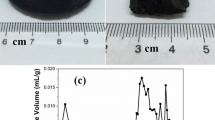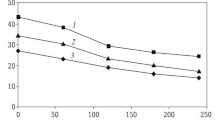The possibility is demonstrated of preparing porous ceramic based on zirconium dioxide micro- and nanopowder using crystallization of carbamide in a suspension. Different suspension cooling regimes are studied for oxide powders (in air, in a freezing chamber, in snow). It is shown that sintered ceramic porosity and pore size depend directly on suspension composition and cooling method. As a result of this ceramic is prepared with porosity of 30 – 60% with pore diameter of 0.2 – 200 μm.






Similar content being viewed by others
References
A. R. Studart, U. T. Gonzenbach, E. Tervoort, et al., “Processing routes to macroporous ceramics: a review,” J. Amer. Ceram. Soc., No. 89 (6), 1771 – 1789 (2006).
U. G. K. Wegst, M. Schecter, and A. E. Donius, “Biomaterials by freeze casting,” Philosophical Trans. Roy. Soc. A: Physical, Mathematical and Engineering Sciences, 368(1917), 2099 – 2121 (2010).
U. Balachandran, T. H. Lee, and C. Y. Park, “Dense cermet membranes for hydrogen separation,” Separation and Purification Technology, 121, 54 – 59 (2014).
Q. B. Chang, Y. L. Yang, X. Z. Zhang, et al., “Effect of particle size distribution of raw powders on pore size distribution and bending strength of Al2O3 microfiltration membrane supports,” J. Europ. Ceram. Soc., 34(15), 3819 – 3825 (2014).
P. S. Liu and G. F. Chen, Porous Materials. Processing and Application, Elsevier (2014).
H. C. Aran, H. Klooster, J. M. Jani, et al., “Influence of geometrical and operational parameters on the performance of porous catalytic membrane reactors,”Chem. Eng. J., 207, 814 – 821 (2012).
A. Cheraitia, A. Ayral, A. Julbe, et al., “Synthesis and characterization of microporous silica-alumina membranes,” J. Porous Mater., 17(3), 259 – 263 (2010).
K. Araki and J.W. Halloran, “Porous ceramic bodies with interconnected pore channels by a novel freeze casting technique,” J. Amer. Ceram. Soc., 88(5), 1108 – 1114 (2005).
Y. F. Tang, S. Qiu, Q.Wu, and C. Miao, “Fabrication of lamellar porous alumina with axisymmetric structure by directional solidification with applied electric and magnetic fields,” J. Europ. Ceram. Soc., 36(5), 1233 – 1240 (2016).
Y. Zhang, L. Hu, J. Han, and Z. Jiang, “Freeze casting of aqueous alumina slurries with glycerol for porous ceramics,” Ceram. Internat., 36(2), 617 – 621 (2010).
S. G. Tresvyatskii, V. D. Tkachenko, and E. P. Garmash, “Grain size dependence of Strength of porous ceramic materials of skeleton structure,” Fiz.-Khim. Mekhan. Materialov, 12, 56 – 60 (1976).
H.-Y. Song, S. Islam, and B.-T. Lee, “A novel method to fabricate porous hydroxyapatite body using ethanol bubbles in a viscous slurry,” J. Amer. Ceram. Soc., 91(9), 3125 – 3127 (2008).
R. M. Khattab, M. M. S.Wahsh, and N. M. Khalil, “Preparation and characterization of porous alumina ceramics through starch consolidation casting techniques,” Ceram. Internat., 38(6), 4723 – 4728 (2012).
Z. Zivcova-Vlckova, J. Locs, M. Keuper, et al., “Microstructural comparison of porous oxide ceramics from the system Al2O3 – ZrO2 prepared with starch as a pore-forming agent,” J. Europ. Ceram. Soc., 32(10), 2163 – 2172 (2012).
E. Mostafavi and A. Ataie, “Destructive interactions between pore forming agents and matrix phase during the fabrication process of porous BiFeO3 ceramics,” J. Mater. Sci. Technol., 31(8), 798 – 805 (2015).
K. Schwartzwalder and A. V. Somers, US Pat. 3090094. Method of manufacturing Porous Ceramic (1963).
Z.-Y. Deng, T. Fukasawa, M. Ando, et al., “High-surface-area alumina ceramics fabricated by the decomposition of Al(OH)3,” J. Amer. Ceram. Soc., No. 84, 485 – 491 (2001).
A. R. Studart, U. T. Gonzenbach, E. Tervoort, et al., “Processing routes to macroporous ceramics: a review,” J. Amer. Ceram. Soc., No. 89 (6) 1771 – 1789 (2006).
A. Harabi, F. Zenikheri, B. Boudaira, et al., “A new and economic approach to fabricate resistant porous membrane supports using kaolin and CaCO3,” J. Europ. Ceram. Soc., 34(5), 1329 – 1340 (2014).
S. Deville, “Freeze-casting of porous ceramics: Areview of current achievements and issues,” Advanced Eng. Mater., 10(3), 155 – 169 (2008).
L. Qian and H. F. Zhang, “Controlled freezing and freeze drying: a versatile route for porous and micro/nano-structured materials,” J. Chem. Technol. Biotechnol., 86(2), 172 – 184 (2011).
A. Cheraitia, A. Ayral, A. Julbe, et al., “Synthesis and characterization of microporous silica-alumina membranes,” J. Porous Mater., 17(3), 259 – 263 (2010).
S. Vijayan, R. Narasimman, and K. Prabhakaran, “Dispersion and setting of powder suspensions in concentrated aqueous urea solutions for the preparation of porous alumina ceramics with aligned pores,” J. Amer. Ceram. Soc., 96(3), 2779 – 2784 (2013).
O. N. Kulish, S. A. Kuzhevatov, E. V. Borodina, and E. V. Kutsenko, “Prospects for developing technology for noncatalytic cleaning of flue gases from nitrogen,” Zashch. Okruzh. Sredy Neftegaz Komplekse, No. 3, 49 – 54 (2005).
Author information
Authors and Affiliations
Corresponding author
Additional information
Translated from Novye Ogneupory, No. 9, pp. 33 – 38, September, 2016.
Rights and permissions
About this article
Cite this article
Kamyshnaya, K.S., Khabas, T.A. Study of Preparation of Prescribed Pore Configuration in Zirconium Dioxide Ceramic Due to Carbamide Directional Solidification. Refract Ind Ceram 57, 490–495 (2017). https://doi.org/10.1007/s11148-017-0010-6
Received:
Published:
Issue Date:
DOI: https://doi.org/10.1007/s11148-017-0010-6




